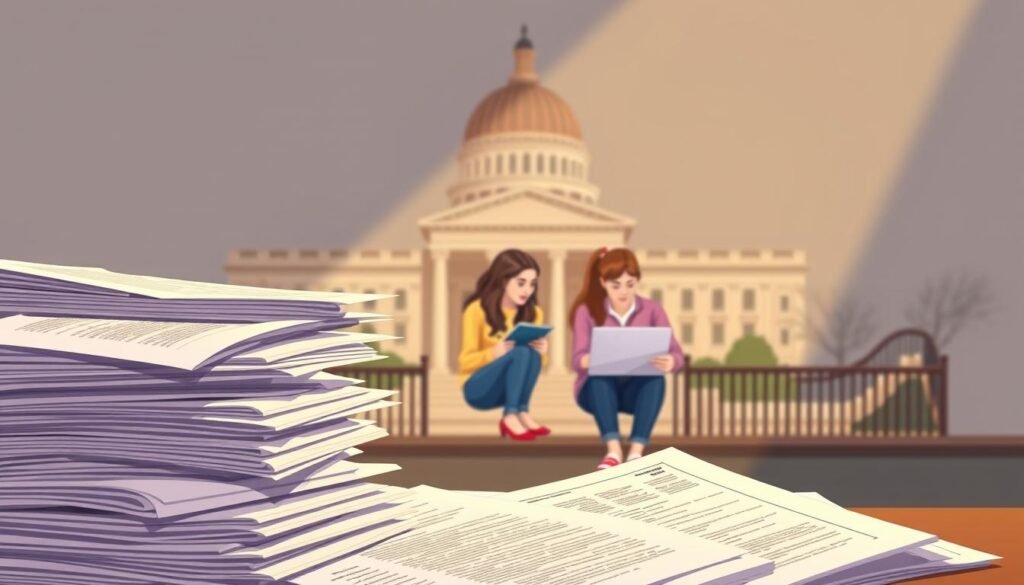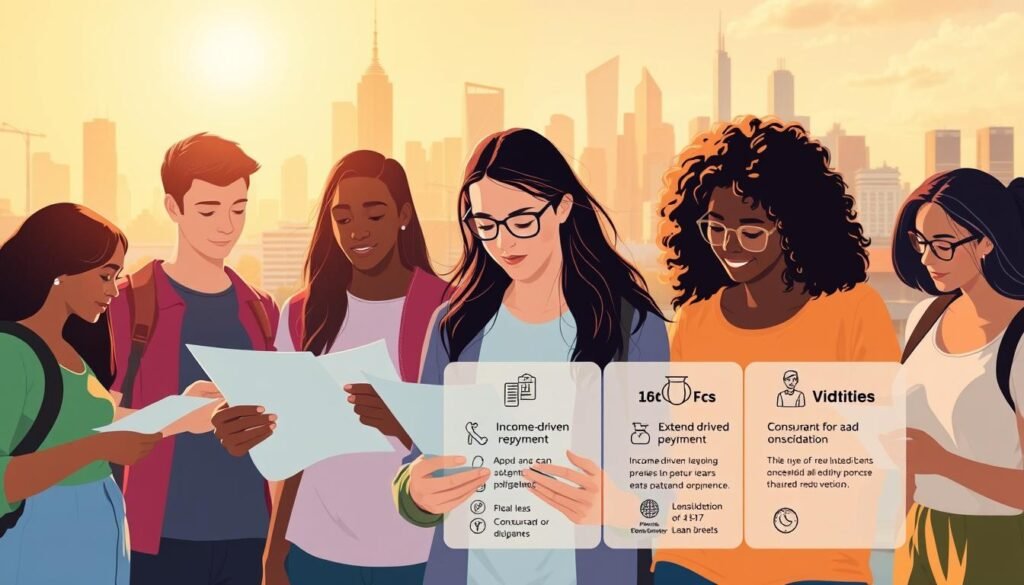Have you ever wondered how to navigate the complex world of financing higher education? With the rising costs of tuition, understanding your options is more critical than ever. Whether you’re exploring federal student loans or considering private student loans, making informed decisions can shape your financial future.
Recent policy changes, such as the resumption of federal loan collections in May 2025, add another layer of complexity. It’s essential to stay updated and plan ahead. Federal loans often come with benefits like income-driven repayment plans, while private loans from providers like Sallie Mae offer unique perks such as 100% cost coverage and no origination fees.
This guide will help you compare loan structures, explore repayment strategies, and understand forgiveness programs. By the end, you’ll have the tools to make confident decisions about your financial aid and repayment options.
Key Takeaways
- Federal loans offer flexible repayment plans and forgiveness programs.
- Private loans like Sallie Mae provide 100% cost coverage and no origination fees.
- Policy changes, such as the May 2025 resumption of federal loan collections, require careful planning.
- Comparing federal and private loan structures helps you choose the best option.
- Understanding repayment strategies ensures long-term financial stability.
Understanding Student Loans: A Beginner’s Guide
Education financing doesn’t have to be confusing—let’s break it down from the ground up. Whether you’re exploring federal student options or considering private student funding, knowing the basics can help you make informed decisions. These tools are designed to bridge the gap between your savings and the cost of higher education.
What Are Student Loans?
Student loans are funds provided by the government or private lenders to cover education expenses. They must be repaid with interest over time. Federal student loans are backed by the U.S. government and often come with benefits like flexible repayment plans. On the other hand, private student loans are offered by banks or credit unions and typically require a strong credit history or a cosigner.
Why Are Student Loans Important for Higher Education?
With tuition costs rising, financial aid plays a crucial role in making education accessible. Federal loans prioritize accessibility, as most don’t require a credit check. Private loans, however, rely on creditworthiness, and having a cosigner can significantly increase approval chances. For example, Sallie Mae reports a fourfold increase in approval likelihood with a cosigner.
To access federal aid, start by completing the FAFSA®. This form is your gateway to grants, scholarships, and loans. Understanding these options ensures you’re prepared to fund your education without unnecessary stress.
Types of Student Loans: Federal vs. Private
Choosing the right financing option for education can shape your financial future. Understanding the differences between federal and private funding is crucial to making informed decisions. Each option comes with its own set of benefits and considerations, so let’s explore them in detail.
Federal Student Loans: An Overview
Federal loans are backed by the U.S. government and offer several advantages. They include Subsidized, Unsubsidized, and PLUS options. Subsidized loans are need-based, with the government covering interest during school. Unsubsidized loans are available to all, but interest accrues immediately. PLUS loans help parents and graduate students cover additional costs.
Federal loan limits range from $31,000 for dependent undergraduates to $138,000 for graduate students. These loans also come with flexible repayment plans and forgiveness programs, making them a popular choice.
Private Student Loans: When to Consider Them
Private student loans are offered by banks, credit unions, and lenders like Sallie Mae. They often provide higher borrowing limits and can cover expenses like technology and equipment. However, they typically require a credit check or a cosigner for approval.
Interest rates for private loans can be fixed or variable, and some lenders offer perks like a 0.25% rate reduction for auto debit. Sallie Mae also extends eligibility to career training programs, making it a versatile option.
Key Differences Between Federal and Private Loans
Eligibility is a major difference. Federal loans require completing the FAFSA®, while private loans rely on creditworthiness. Federal options often have lower interest rates and more flexible repayment terms. Private loans, on the other hand, may offer higher limits and unique benefits like tech coverage.
Another key difference is interest capitalization. Federal loans may delay interest accrual, while private loans often capitalize interest immediately. Understanding these distinctions helps you choose the best option for your needs.
Federal Student Loans: What You Need to Know
Navigating federal funding options can simplify your education journey. These programs are designed to make higher education accessible, offering flexible terms and benefits. Whether you’re an undergraduate student or pursuing advanced studies, understanding your options is crucial.
Direct Subsidized and Unsubsidized Loans
Subsidized loans are ideal for undergraduate students with financial need. The government covers interest payments while you’re in school, making them a cost-effective choice. Unsubsidized loans, on the other hand, are available to all students, but interest accrues immediately.
Direct PLUS Loans for Parents and Graduate Students
Parent PLUS and Grad PLUS loans help cover additional education costs. These require a credit check but offer higher borrowing limits. They’re a great option for families or graduate students who need extra support.
Eligibility Requirements for Federal Loans
To qualify, complete the FAFSA® and meet specific criteria. Your school must certify your enrollment, and aggregate loan limits vary based on dependency status. Note that the Biden administration has paused IDR processing, so stay updated on policy changes.
Federal loans also come with a repayment plan tailored to your financial situation. Understanding these details ensures you make the most of your financial aid options.
Private Student Loans: Benefits and Considerations
Private funding can be a powerful tool to bridge the gap in education costs. Unlike federal options, private financing often provides higher borrowing limits and tailored solutions. Understanding how these loans work, their terms, and the role of a cosigner can help you make informed decisions.
How Private Student Loans Work
Private financing requires school certification before disbursement. Funds are typically sent directly to your institution, and the process follows a 30-day rule. This ensures the money is used for approved education expenses.
Lenders like Sallie Mae allow up to 100% cost of attendance coverage. This includes tuition, books, and even technology. After graduation, you may have a 12-month grace period for interest-only payments.
Interest Rates and Repayment Terms
Interest rates for private financing can be fixed or variable. Fixed rates remain constant, while variable rates may change based on market conditions. For example, Sallie Mae uses the SOFR benchmark for variable rates.
Repayment terms vary by lender. Some offer auto-debit discounts, reducing your interest rate by 0.25%. Always compare terms to find the best fit for your financial situation.
The Role of a Cosigner in Private Loans
A cosigner can significantly increase your chances of approval. In fact, 91% of undergraduate applications are approved with a cosigner. This person shares responsibility for repayment, so choose someone with a strong credit score.
Refinancing is another option to consider. It can lower your interest rate or adjust your loan amount. However, be cautious not to overborrow. Use tools like BLS.gov income data to plan responsibly.
Repayment Plans for Student Loans
Understanding your repayment options is key to managing your financial future. Choosing the right plan can help you stay on track and avoid unnecessary stress. Let’s explore the different strategies available to help you pay back your education financing effectively.
Standard and Graduated Repayment Plans
The standard plan spreads your monthly payments evenly over 10 years. It’s a straightforward option with predictable costs. Graduated plans, on the other hand, start with lower payments that increase every two years. This can be helpful if you expect your income to grow over time.
Income-Driven Repayment Options
Income-driven plans like SAVE and PAYE cap your monthly payments at 10% of your discretionary income. These plans are ideal if your income fluctuates or is lower than expected. Recent changes have simplified the recertification process, making it easier to stay enrolled.
Extended and Income-Contingent Plans
Extended plans stretch your repayment term to 25 years, reducing your monthly payments. Income-contingent plans adjust based on your income and family size. Both options provide flexibility but may result in higher interest over the life loan.
Remember, forgiven balances under income-driven plans may have tax implications. Use tools like the FSA’s Loan Simulator to find a plan that fits your financial situation. Planning ahead ensures you can manage your payments with confidence.
Student Loan Forgiveness and Discharge Programs
Exploring forgiveness and discharge programs can provide significant relief for borrowers managing education debt. These programs are designed to help individuals reduce or eliminate their financial obligations under specific conditions. Understanding your eligibility and the application process is key to taking advantage of these opportunities.
Public Service Loan Forgiveness (PSLF)
The Public Service Loan Forgiveness program is a valuable option for government and nonprofit employees. To qualify, you must make 120 qualifying payments while working full-time for an eligible employer. This program can completely erase your remaining balance after meeting the requirements.
Recent updates have simplified the process, but it’s essential to stay informed about policy changes. The Biden administration has paused mass forgiveness efforts, so borrowers should monitor updates and ensure their payments count toward the 120 required.
Teacher Loan Forgiveness Program
Teachers serving in low-income schools may qualify for the Teacher Loan Forgiveness program. This initiative offers up to $17,500 in forgiveness after five consecutive years of service. It’s a great way to reduce your debt while making a positive impact in underserved communities.
Eligibility depends on your teaching role and the school’s classification. Be sure to verify your qualifications and submit the necessary documentation to access this benefit.
Total and Permanent Disability Discharge
Borrowers with a total and permanent disability may qualify for a discharge of their federal loans. This program requires medical documentation to prove your condition. Once approved, your remaining balance is forgiven, providing much-needed financial relief.
The process involves submitting proof from a licensed physician or the Department of Veterans Affairs. If you meet the criteria, this program can significantly ease your financial burden.
For borrowers at risk of default, the FSA’s Default Resolution Group offers outreach and support. Staying proactive and exploring these programs can help you manage your debt effectively and avoid long-term financial challenges.
Managing Your Student Loan Debt
Taking control of your debt starts with smart strategies and informed decisions. Whether you’re looking to reduce your loan payments or explore refinancing options, there are steps you can take to ease the burden. Let’s dive into practical tips to help you manage your financial obligations with confidence.
Tips for Lowering Your Interest Rates
One of the best ways to reduce your debt is by lowering your interest rate. Many lenders, like Sallie Mae, offer a 0.25% discount for setting up auto-debit. This small change can add up over time. Additionally, consider the avalanche method—targeting high-interest debts first to save on principal interest.
How to Make Extra Payments on Your Loans
Making extra payments can significantly reduce your debt. When you pay more than the minimum, the additional amount is applied to fees, interest, and then the principal interest. Biweekly payment strategies can also help you pay off your debt faster while reducing total interest.
Refinancing and Consolidation Options
Refinancing can be a game-changer if you qualify for a lower interest rate. Federal consolidation retains eligibility for income-driven repayment plans, while private refinancing may offer better terms. However, weigh the risks—private refinancing can lead to wage garnishment if you default.
Financial Planning for Student Loan Borrowers
Effective financial planning is essential for borrowers balancing education costs and repayment. With the right strategies, you can manage your obligations while building a stable financial future. Let’s explore practical steps to help you stay on track.
Budgeting for Loan Payments
Creating a budget is the first step toward financial stability. The 50/30/20 rule is a great starting point—allocate 50% to needs, 30% to wants, and 20% to savings and debt repayment. Prioritize your repayment plan to avoid falling behind.
Emergency funds are also crucial. Aim to save enough to cover 3-6 months of payments. This buffer can protect you from unexpected financial challenges.
How to Avoid Defaulting on Your Loans
Defaulting can have serious consequences, including damage to your credit check score. If you’re struggling, explore deferment or forbearance options. These can temporarily pause or reduce your payments.
The FSA’s enhanced IDR process eliminates annual recertification, making it easier to stay enrolled in income-driven plans. Stay proactive to avoid late-stage delinquency.
Long-Term Financial Strategies for Graduates
Investing in your career can boost your income and ease repayment. Consider certifications, side hustles, or career training programs. Sallie Mae’s loans, for example, cover training costs, helping you grow professionally.
Focus on long-term financial strategies like refinancing or consolidation. These can lower your interest rates and simplify payments. Always weigh the risks and benefits before making decisions.
Conclusion: Taking Control of Your Student Loan Journey
Taking charge of your financial obligations starts with understanding your options. Prioritize federal loans for their flexible repayment options and forgiveness programs. Always communicate proactively with your loan servicer to stay informed about your account.
Utilize resources like Sallie Mae’s application portal and the FSA’s tools to manage your loans effectively. Be cautious of scams targeting borrowers—legitimate services won’t ask for upfront fees.
By staying informed and proactive, you can secure your financial future and reduce stress. Managing interest rates and repayment terms doesn’t have to be overwhelming. Take control today and pave the way for a brighter tomorrow.
FAQ
What are the main types of financial aid available for higher education?
The primary options include federal aid, private funding, scholarships, and grants. Federal aid often offers lower interest rates and flexible repayment plans, while private funding may require a credit check or cosigner.
How do federal and private funding differ?
Federal options are backed by the government, offering fixed interest rates and income-driven repayment plans. Private funding, on the other hand, is provided by banks or lenders and may have variable rates, requiring a strong credit history or cosigner.
What is the difference between subsidized and unsubsidized federal options?
Subsidized options do not accrue interest while you’re in school at least half-time, during the grace period, or deferment. Unsubsidized options, however, start accruing interest immediately, increasing the total amount you’ll pay back.
When should I consider private funding?
Private funding can be a good choice if you’ve maxed out federal options or need additional funds. However, make sure to compare interest rates, repayment terms, and the need for a cosigner before applying.
What are income-driven repayment plans?
These plans adjust your monthly payments based on your income and family size, making them more manageable. Options include Income-Based Repayment (IBR), Pay As You Earn (PAYE), and Revised Pay As You Earn (REPAYE).
Can I refinance my existing financial obligations?
Yes, refinancing allows you to combine multiple obligations into one, potentially securing a lower interest rate. This can simplify payments and reduce the total amount paid over time.
What is Public Service Loan Forgiveness (PSLF)?
PSLF forgives the remaining balance after 120 qualifying payments for those working full-time in public service jobs. This program is available for federal options only.
How can I avoid defaulting on my financial obligations?
Stay on top of payments, explore income-driven plans, or request deferment or forbearance if needed. Communication with your lender is key to finding a solution that works for you.
What role does a cosigner play in private funding?
A cosigner agrees to take responsibility if you’re unable to make payments. Having one can help you secure a lower interest rate or qualify for a larger amount, especially if your credit history is limited.
Are there forgiveness programs for teachers?
Yes, the Teacher Loan Forgiveness Program offers up to ,500 in forgiveness for eligible educators who work in low-income schools for five consecutive years.









